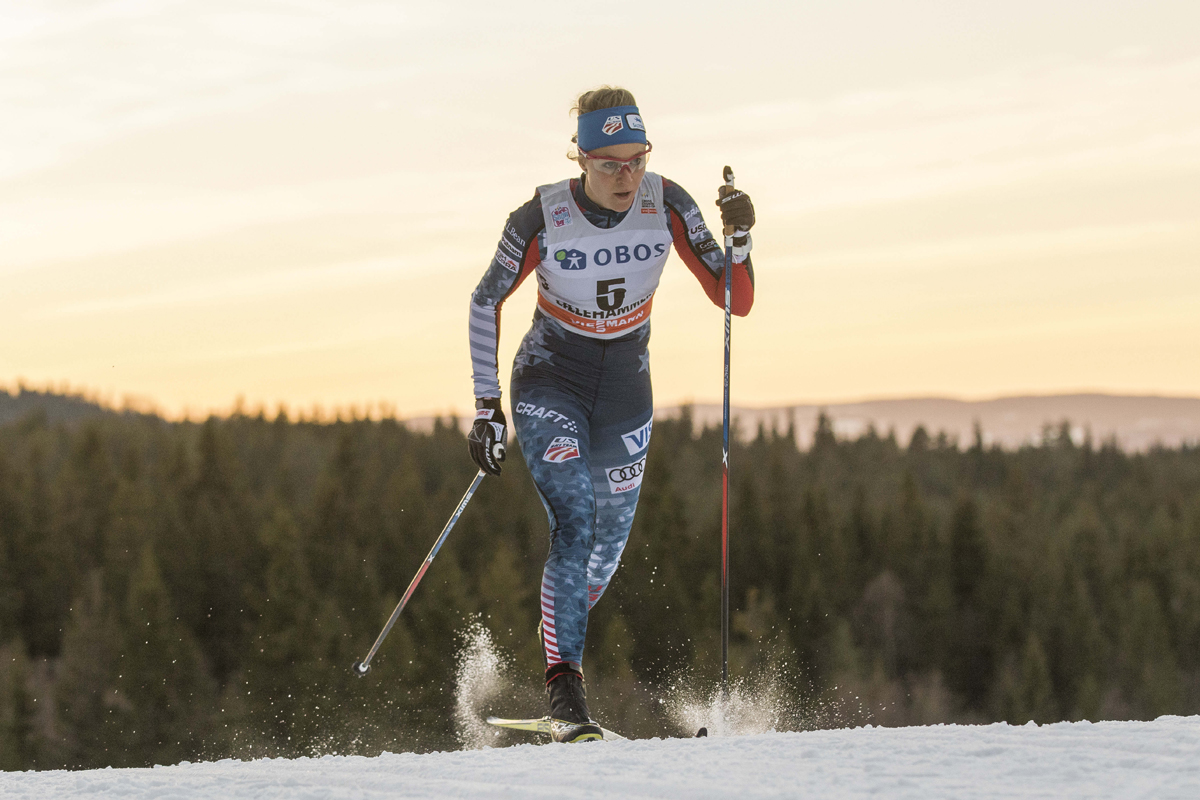
LILLEHAMMER, Norway — If anything’s consistent after two days of classic sprinting on the Cross-Country World Cup this year, it’s that nothing is a given — especially on the women’s side of World Cup sprinting.
No more Maiken Caspersen Falla dominating every World Cup sprint. However, Norway’s defending Sprint World Cup champion is no slouch, placing second in both classic sprints so far this season.
Take Sadie Bjornsen, for example. In her sixth time classic skiing in the last couple months (because of problematic heel spur), she clocked the fastest qualifying time in the women’s 1.3-kilometer classic sprint on Friday morning, 0.29 seconds faster than Falla, who qualified second.
“… I’m actually so happy I’m even here, and also that’s so crazy I was the fastest person in the world today,” Bjornsen reflected on the phone Friday evening. “That’s something you can’t forget.”
It wasn’t totally out of the blue. Bjornsen won a freestyle sprint qualifier last season in Quebec at the Ski Tour Canada (STC) World Cup stage.
“I hadn’t done that in classic so that was really fun,” Bjornsen, who turned 27 last week, said.
On Day 1 of Lillehammer’s three-day mini tour, the other big name in the women’s race was Norway’s Heidi Weng, who won her first-ever World Cup sprint after placing third in both races last weekend. (She also qualified third on Friday, 0.36 seconds behind Bjornsen). Weng’s teammate and the favorite in most races, Marit Bjørgen didn’t qualify for the final after finishing fourth in her semifinal, 0.71 seconds behind Weng, for eighth overall.
But let’s go back to Bjornsen for a moment. Her winning qualifying time was 3:19.62 minutes, which would have put her fifth in the final had she made it that far. Bjornsen was eliminated in the quarterfinals after placing fourth in her heat and ended up 17th for the third-straight race this season.
That was frustrating, but a phone call with her coach back in Alaska helped her regain perspective.
“I actually had an awesome chat with Erik [Flora] back to the U.S.,” she said. “He was like, ‘Who cares what happened? You were the fastest in the world.’ ”
Teammate Kikkan Randall, who wasn’t picked for this weekend’s mini tour, also gave her some words of advice at the finish.
“She handed me Breck for a little hug right after,” Bjornsen said of Randall’s seven-month-old infant. “He’s like the team cheer-up.”
Bjornsen raced in the same quarterfinal as teammate Jessie Diggins, who qualified in ninth (+1.75). Last week, Diggins qualified 13th. Last year, her best qualifying result in a classic sprint was seventh.
“Last year, going into the start of the season, I had never qualified in a classic sprint ever in the World Cup,” Diggins noted in a phone interview on Friday. “Now I feel like I have the fitness to make it into the semi. I’m in a different place than I was last year.”
Facing off against Russia’s Yulia Belorukova and Norway’s Kathrine Rolsted Harsem in the quarterfinal, along with Germany’s Sandra Ringwald and Finland’s Kerttu Niskanen, Diggins and Bjornsen stuck in the middle of the pack — both frustrated with their positioning.
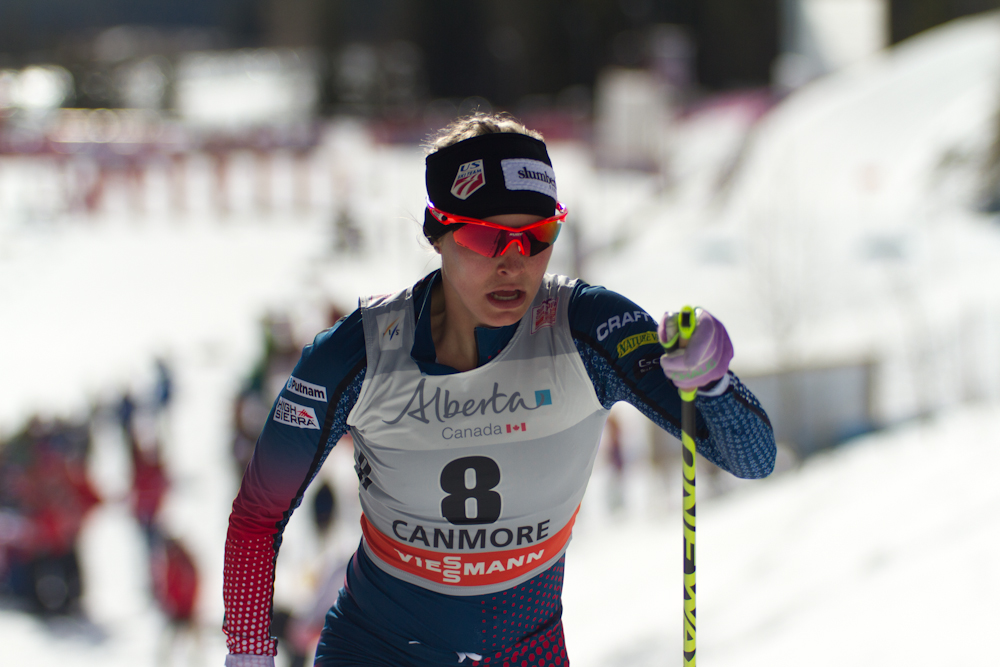
For Diggins, who led Bjornsen for much of the race and ended up just ahead of her in third (for 14th overall), it was about finding her rhythm on the uphills. She was pleased with the way she skied her qualifier, but felt like she wasn’t skiing to her potential in the quarterfinal.
“It’s kind of funny because when I get in a heat setting, I get really nervous having all these people around me,” Diggins said.
She recalled leading Bjornsen until the first big climb, where Bjornsen made a move on the outside and Diggins stepped right to let her pass. She tucked behind her over the top, and sitting in fourth at the time, thought about how to get herself closer to the top two (Harsem, who set a fast pace early, and Belorukova).
Skis weren’t a problem, Diggins said, but the chewed-up tracks presented some difficulties.
“I remember thinking, ‘Oh my gosh, Sadie’s right behind me. I really gotta go!’ ” she said. “I think I got a little too stressed and I was not really going anywhere, which is too bad because I know the fitness is there. … When the tracks break down I feel like one of those cartoon characters where I’m spinning my wheels…
“It has nothing to do with the skis, the skis were great,” Diggins added. “… In the finish, I was psyched to feel good again. Double poling is my strength.”
Despite a big push for second, Diggins finished 0.08 seconds back from the runner-up in that heat, Harsem, and 0.22 seconds behind the winner, Belorukova. Bjornsen was another 0.6 seconds back in fourth.
“I probably wasn’t aggressive out of the start as I should have been,” Bjornsen reflected.
After feeling like she started too hard in her quarterfinal last Saturday in Finland, she decided to try to conserve a bit more early in this race.
“I just felt like I was fighting the whole time to try to go, but wasn’t really feeling like I could get in the right position,” Bjornsen said. “I just didn’t feel like I could get in quite the correct place. It didn’t go as I would’ve liked.”
But she had some good takeaways from Friday’s sprint, and was feeling positive heading into the next two days of racing in Lillehammer.
“I feel like every time I do a sprint race, it’s great practice for me,” Bjornsen said. “I’m not somebody who can naturally see gaps and jump on them so I have to practice that…”
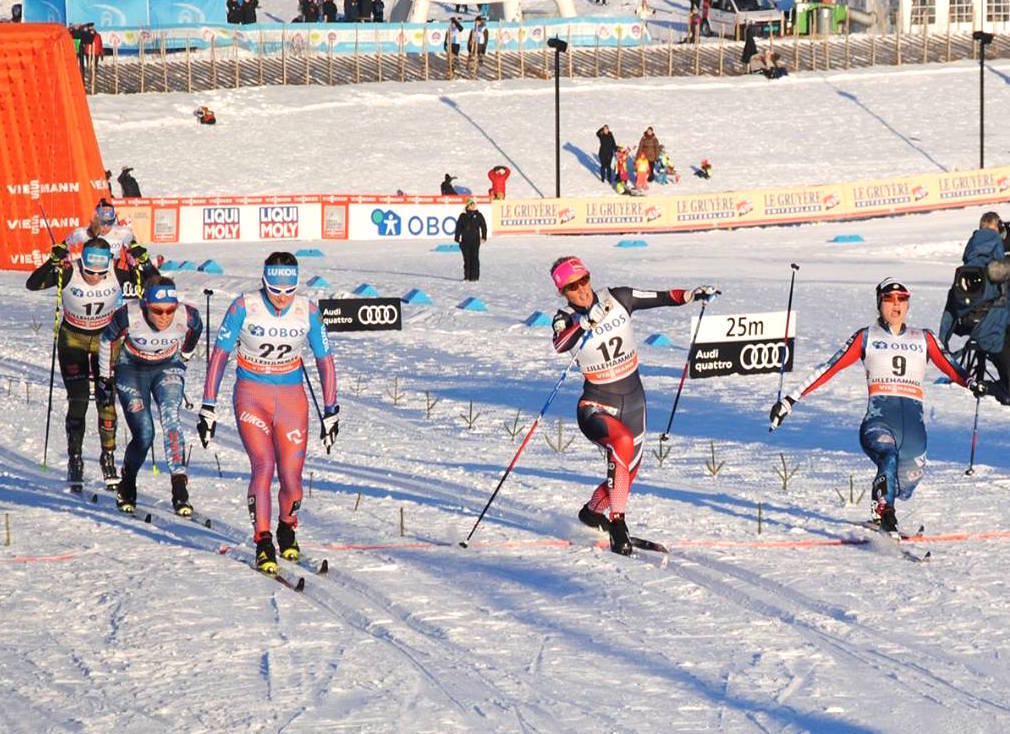
Two other Americans qualified for the heats: Sophie Caldwell in 10th (+2.01 behind Bjornsen) and Ida Sargent in 26th (+6.17). Caldwell went on to place 21st overall after finishing fifth in her quarterfinal, and Sargent was 28th after placing sixth in her quarterfinal.
“We kicked off the day feeling like we’re a different team from last weekend,” U.S. Women’s Coach Matt Whitcomb said on the phone. “We had three women qualify in the top 10, including Sadie’s career-qualifier win, which was always so exciting, to watch someone like Sadie suceed that way, and then Ida qualified — a little piece of trivia — for the first time in Norway.”
Caldwell explained in an email that she struggled out of the start of her quarterfinal.
“There was a lot of lane changing happening so I found myself at the back of the pack pretty quickly,” she wrote. “Once I was back there, I think I got a little frantic and frustrated and ended up losing some steam and staying towards the back of the pack.”
Coming out of the final hill, she remembered skiing in fifth or sixth.
“[I] caught a decent draft coming into the finish stretch, but I was a little out of steam and didn’t have a very strong double pole finish,” she added.
Caldwell crossed the line in fifth, 3 seconds behind Falla as the winner of that heat.
“I haven’t come into the season with a bang, but I usually don’t and I feel like I’m taking a step in the right direction with each race effort,” she wrote. “I was really happy with my qualifier today and pretty happy with my quarter final last weekend and to qualify in classic sprints, especially in period one, used to a pretty big stretch for me. So I feel like I’m making some progress and looking forward to a long season ahead!”
Sargent wrote in an email that she was pleased with her qualifier, considering how competitive the field was.
“I tried to go with slightly slick skis but it didn’t end up being a great approach for me, and I was very tense on the uphills,” she wrote of her qualifier. “.. But my energy felt really good. So I was happy to still qualify with not a great feeling out there.
“I wasn’t as happy with the quarterfinal,” Sargent continued, after finishing 8.24 seconds behind Finland’s Krista Parmakoski, who won the quarterfinal in 3:14.57, the fastest time of the day. “The lane that I was in ended before the big uphill so I had to jump in behind people from the start and felt like I was skiing from the back and wasn’t able to find an opening … I couldn’t get the same energy going in the heat and was just feeling kind of tired so I ran out of steam over the top of the last hill.”
She explained her skis were “awesome” in her quarterfinal, but speculated that she may have spent too much time and energy testing them.
“I know I can improve the way that I warmup and cooldown from the heats and dial in my ski testing so I’m still figuring out that routine and glad there is lots of racing yet to come this season,” Sargent concluded. “Overall it feels like a solid start for me this year but I know that I have a lot more in the tank so I’m excited for more racing!”
“We’re still struggling to find a stable platform,” Whitcomb said of the team in general. “We’re new to snow, things got a little bit mealy [with the course conditions], and while the energy certainly looked better for a one-off qualifier, and even at times for the quarters, I just don’t think we were ready yet to put together a full four rounds of sprinting.
“That said, Jessie was absolutely on fire near the end of her quarterfinal, and had she advanced, which she nearly did by half a meter, I think the day could have looked a lot differently,” he added. “There was no one in the women’s field who had a more impressive drag race in the last 100 meters, so I’m in no way disappointed. I feel like we skied representative of where we are right now.”
Weng for the Win
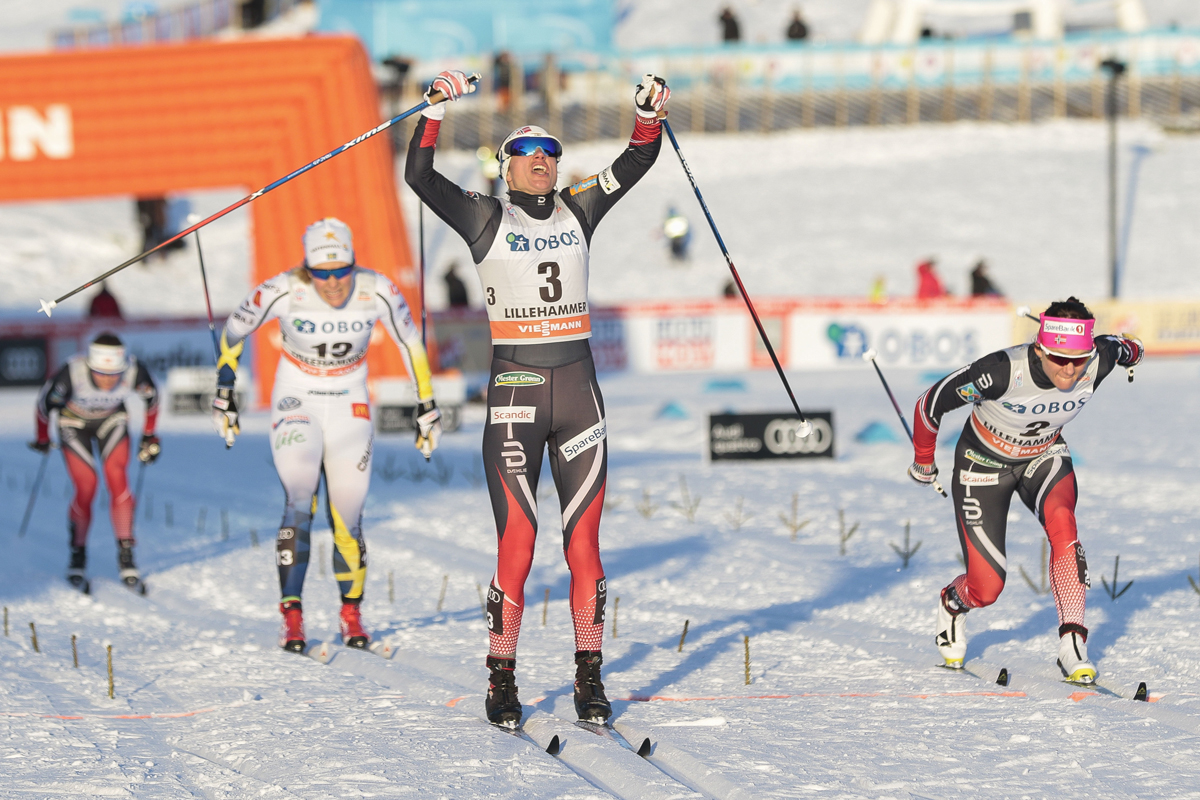
At the top of the results, Weng won her quarterfinal and semifinal before outlasting five others once again in the final. She bested her teammate Falla by 0.48 seconds with a winning time of 3:15.76, and Sweden’s Hanna Falk placed third (+1.06). Of the four Norwegian women in the final, Ingvild Flugstad Østberg placed fourth (+2.99) and Anna Svendsen was fifth (+6.27). Russia’s Belorukova finished sixth (+16.75).
Falla took an early lead and Østberg jumped in behind her to follow closely in second. While Sweden’s Falk strained to put herself in third, Weng sat back and eventually seized the opening — chasing Falla and Østberg as the three Norwegians took hold of the race.
Falla began to gap her teammates on the final climb, but Weng strided powerfully into second while Falk moved back into third. In the finishing stretch, Weng proved strongest as she double poled past Falla for her first sprint World Cup win (after 10 sprint podiums).
It was evident that the win meant a great deal to Weng as she raised her arms in the air and screamed as she crossed the line. Asked at a post-race press conference why she did that, Weng responded, “I was very happy!”
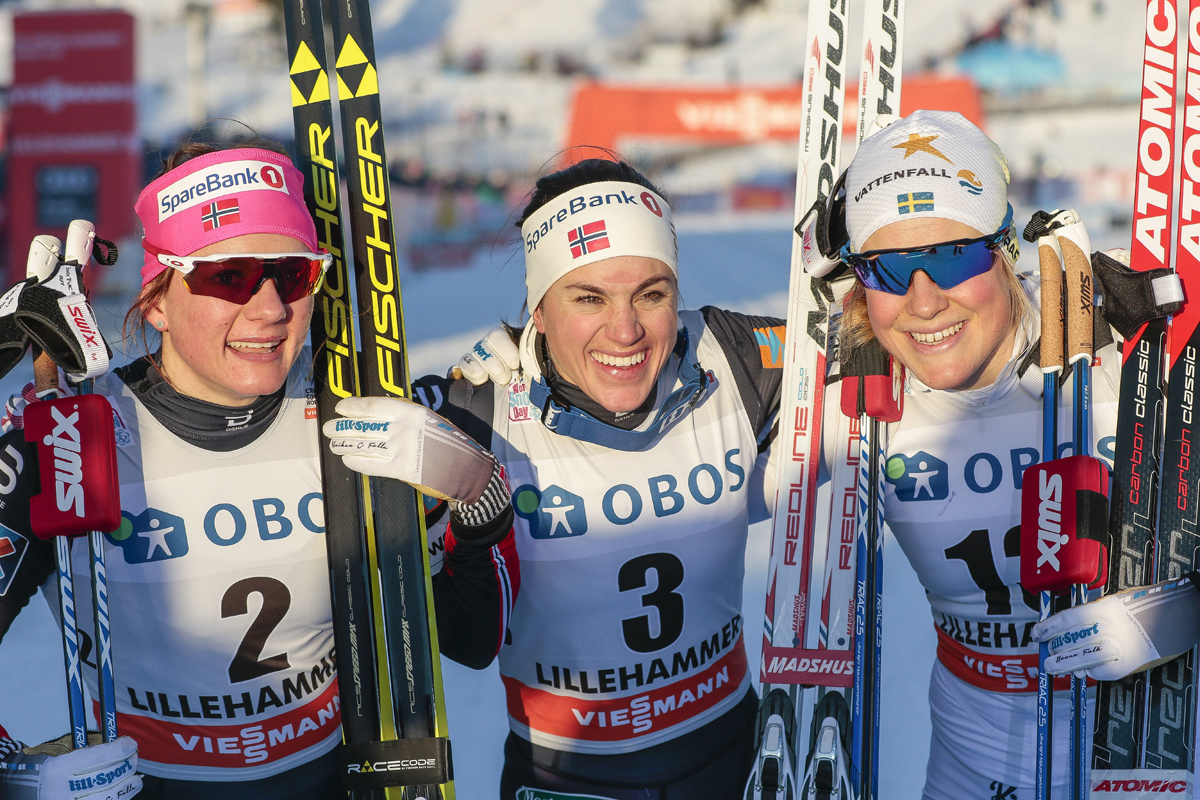
But immediately after the race, she wasn’t sure what to say.
“It’s incredible to go so fast in sprint and I’m…,” she said in a finish-line interview.
The interviewer asked, “You are speechless?” to which Weng lit up and firmly answered, “Yes!”
Weng spoke to a group of Norwegian journalists after, and when she was asked about her performance, she said, “This may be one of the greatest performances in my career. I figured before the final that I should just give it all that I have, and during the final climb I had to take a few detours, but it worked out in the end.”
For the 25-year-old Weng, one of the most consistent podium threats on the circuit, this was only her third World Cup victory. She said that she hadn’t really worked on improving her sprinting,“but I have been focusing on my techinique as usual during my workouts.”
Three other Americans and three Canadian women raced in the qualifier. Rosie Brennan of the U.S. Ski Team (USST) was closest to qualifying in 34th, about a second out of the top 30. Canadian World Cup B-team member Emily Nishikawa placed 62nd, followed by Canadian U25-Team teammates Dahria Beatty and Cendrine Browne in 66th and 67th, respectively. American Caitlin Patterson (Craftsbury Green Racing Project) placed 68th, and USST distance specialist Liz Stephen was 70th in her first race of the season.
Results: Qualifier | Heats | Mini-tour standings (after Day 1)
Aleks Tangen
Aleks is a freelance journalist based in Gjøvik, Norway, covering ski-related sports and track & field. He also works part time as a model and reads a new book almost every week.



